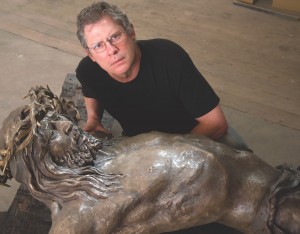Artists perform a strange alchemy, turning colors, nouns, and notes into landscapes, sonnets, and string quartets. Sometimes they perform an even greater magic by shaping images that keep us going, even in the darkness. As St. Augustine said, they provide the means of transport to move us along our journey. Our life, the Bishop of Hippo wrote, is a journey of the affections, which is meant to bring us to our true homeland in God. Many things attract our affections and move us, but they only take us forward when they are loved for the sake of God—as he insisted: all things are to be loved in God and God is to be loved in all things. We love signs (or symbols) for how they move us. As he wrote: “We love the means of transport only because of our destination.”1
Intuitively artists want to create experiences that move us, that transport us to another place. They want not just to make a nice melody, but one that we didn’t know to listen for; to shape words that shock and delight. Artists push us to see and hear what doesn’t yet exist, but should.
But should! Here is where the imagination, the dreaming of the artist is indispensable. Here is where the faith of the Christian comes into play. Christians believe God has given us a preview, a downpayment, of something we didn’t know to look for: the Resurrection of Jesus from the dead. Because of this, we have the audacity to imagine another world. I have been struck recently by Jesus’s response to the death of his friend Lazarus as John remembers it in chapter 11. When Jesus hears the news of Lazarus’s death, in the midst of his own grief, he tells Martha: “Your brother will rise again” (John 11:23). “Oh yes I suppose,” Martha answers vaguely, “in the last day.” Oh yes, in some other world. Then Jesus says it is not some other world, it is this world that is being transformed. He says to Martha: “I am the resurrection and the life. Those who believe on me though they die, will live, and everyone who lives and believes in me will never die.” This promise echoes over every Christian grave, but Jesus does not end there: He turns to Martha (as to us) and asks: “Do you believe this?” Can you imagine resurrection?
As poet Julia Esquivel writes:
What keeps us from sleeping
Is that they have threatened us with resurrection! . . .
Accompany us, then on this vigil
And you will know what it is to dream!
You will know then how marvelous it is
To live threatened with resurrection!
“Do you believe this?” Can you make room for resurrection? To be honest, not on most days. The artist often feels like Ezekiel in the middle of a valley filled with dry bones. God asks Ezekiel, as Jesus would Martha: “Mortal, can these bones live?” Ezekiel says: “O Lord you know.” God presses Ezekiel: “Prophesy to these bones . . . thus says the Lord God to these bones: I will cause breath to enter you and you shall live” (vv. 4, 5). God will do it but Ezekiel must carry the message: Prophesy to these dry bones. Ezekiel might have responded: “Come again? God, I have prophesied to all Israel by the river, and no one listened, now will these bones hear?” Yes, says God, prophesy to them. Say to them “breath shall enter you and you shall live” (v. 5). They say, “our bones are dried up and our hope is lost.” But you will prophesy, in God’s name: “I am going to open your graves and bring you up from your graves.” (vv. 11, 12).
I know what you are thinking. We may be threatened by resurrection, but we are also tormented by suffering and by the cold face of death. Artists work in the shadow of earthquakes and violence, of the horrors of nature turning against us, of bodies that betray us, of the valley of the shadow of death. How do they respond to such challenges? How can art contribute to healing?
Something happened in Japan, two weeks after the recent tragedies, that provides a clue. While the horror still unfolded, there appeared on page 14 of the mass circulation Asahi Daily, in the spot reserved for poetry, something amazing—even healing. It was a haiku by Yoshikatzu Kurota:
About the nuclear power plant
too much detail I hear
such unhappiness.
Soon there were more, and then, a virtual torrent: Yasuharu You, 78, a Buddhist monk, had written one commemorating his experience in the 2004 earthquake:
It’s cold and wet
camping outdoors
Aftershocks multiplying the misery.
This year he followed up with this poem:
Days of disaster
I can never forget
the cold and wet.
Murasaki Sagano submitted this tribute to her mother who died five days after the tsunami:
Mother’s pain
into the spring sea
her last sleep.
In our metropolitan paper, beside the story of these haiku was the headline of another article: “Japan’s government urges more residents near the damaged Fukushima to leave their homes.” The poetic makes room for us to go on living; we survive by making aesthetic sense of things. This becomes our mode of transport; it carries us through. But the Christian wants to go further, stubbornly peering through the darkness toward a particular future, often straining to make it out. And the question of Jesus rings in our ears: Do you believe this?
About a month after the tsunami, the Bach Collegium Japan under the leadership of Masaaki Suzuki performed the B Minor Mass at Carnegie Hall in New York City. Before the concert, Carnegie Hall Director Clive Gillinson recalled the tragedy when introducing the Collegium. No one needed a reminder, it was in everyone’s mind. But what did Bach have to say to such a disaster? New Yorker music critic Alex Ross said in his review: “From the first colossally churning chords it was clear that Bach had heard the news in advance.”2 What news? Darkness, but also the ethereal chorus above the churning chords: Christ, have mercy, Lord have mercy, Christ have mercy. And behind these there were echoes of other words: I am the resurrection and the life.

Award-winning sculptor Christopher Slatoff is [at time of publication] an artist-in-residence with the Brehm Center for Worship, Theology, and the Arts at Fuller; an advisory board member and chairman of the sculpture committee of the California Art Club; and a teacher at The Getty Museum, California State University Long Beach, and Art Center College of Design in Pasadena, CA. For more on his work, go to www.slatoffsculpture.com.
There is something more specific that the Christian faith provides the artist besides hope and a future, which at times may contribute more than anything else: that is the lament. The lament is a liturgical form of prayer that takes God’s promises seriously and asks why they are not visible. They make up a substantial portion of the Psalms that were used in Israel’s worship, most famously, Psalm 22:1, 2 which Christ repeated on the cross:
My God, my God why have you forsaken me?
Why are you so far from helping me,
from the words of my groaning?
O my God, I cry by day, but you do not answer;
and by night, but find no rest.
What a strange form of worship: why should our complaint about God’s apparent indifference be a part of our prayer? The truth is, these laments play little or no role in our contemporary worship. Kathleen Billman and Dan Migliore in their book on lament studied a range of modern liturgies and found that the Psalms of lament were consistently omitted in the Scripture readings, even when they formed part of the day’s lectionary. But the lament, as a prominent part of Israel’s worship, suggest that our cries for help are a necessary and appropriate part of our life with God. Without this, Billman and Migliore, say, “there is no recognition of the real bondage and alienation of present reality . . . no genuine cry for deliverance, and no openness for new acts of God’s grace.”3
But for our purposes, here is the important point: At the end of the day, lament is a poetic category. Lament gives aesthetic form to both our dismay over suffering and our hope in God. As beauty is meant to move us toward God, so the lament shapes our prayers in a way that moves us toward connecting tragedy with God. It shapes our desperate cries into prayers for deliverance. I am always struck by the tendency people have to ask when tragedy strikes: Where is God? Many even want to blame God: if God were good and all-powerful as people say, why can’t these disasters be stopped? Why must the children die? This complaint comes naturally to our lips, uttered both by Christians and by people of no faith (and often given as the reason for the loss of faith). I believe there is something sound in this impulse; sometimes there are things so earthshaking, so incomprehensible, that only God can help. These events seem somehow to call our attention to God. This is why the lament must become more a part of our active Christian imagination, and of our artists’ vocabulary: for it is to God that we must direct our anguished cries. For God not only hears, but he has himself taken up these cries on the cross, and he invites the artist to shape them into something that carries us through. That brings us home to God.
ENDNOTES
1. On Christian Teaching, trans. R. P. H. Green (Oxford University Press, 1997), p. 27.
2. “The Book of Bach,” New Yorker, April 11, 2011, p. 86.
3. Rachel’s Cry: Prayer of Lament and Rebirth of Hope (Cleveland: United Church Press, 1999), p. 126.
This article was published in Theology, News & Notes, Spring 2012, “Groanings Too Deep for Words: Engaging the Senses in Worship, Theology, and the Arts.”

